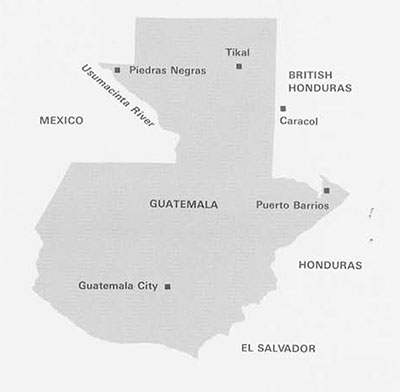 The five numbered “Miscellaneous Sculptured Stones” illustrated here were gathered by Museum expeditions to Piedras Negras, Guatemala, in the ’30’s. The site was already famous for the high quality of its sculptured monuments, and more were found by these expeditions, including carved fragments of monuments of known types which had been broken up and then used as mere building materials in masonry temples, palaces, and platforms. The five stones to be discussed here also served as building blocks, but the designs on them cannot be thus explained. I will try to indicate why I think four of them, if not all five, are practice exercises by apprentice sculptors learning the trade under masters who produced some of the finest Maya sculpture of the Classic Period.
The five numbered “Miscellaneous Sculptured Stones” illustrated here were gathered by Museum expeditions to Piedras Negras, Guatemala, in the ’30’s. The site was already famous for the high quality of its sculptured monuments, and more were found by these expeditions, including carved fragments of monuments of known types which had been broken up and then used as mere building materials in masonry temples, palaces, and platforms. The five stones to be discussed here also served as building blocks, but the designs on them cannot be thus explained. I will try to indicate why I think four of them, if not all five, are practice exercises by apprentice sculptors learning the trade under masters who produced some of the finest Maya sculpture of the Classic Period.
If this was the nature of these designs, after (perhaps) they had been criticized by the master sculptor they would have had little or no further value. But why were all five stones bearing this specialized “art” used in masonry, rather than being tossed aside on a dump? A reasonable answer is that one would find suitable material on which to practice at the site of some building under construction, or at the quarry being worked to supply the building stone for it. Having been used for a special temporary purpose, the incised stones would naturally find their way into the masonry for which they had been quarried in the first place.
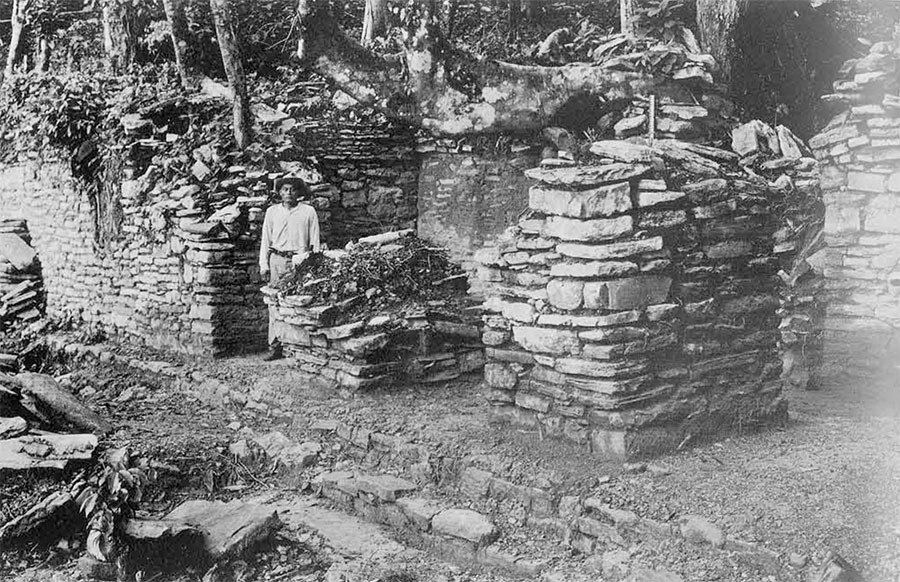
We would not expect this in regions such as that of Tikal, where the stone is very soft and any flat surface must be artificially produced. But at Piedras Negras and other sites of the Usumacinta valley the stone used for facing masonry walls and vaults was split off from relatively hard limestone beds of varying thickness, often quite thin. The thinner slabs were laid flat, as may be seen in Fig. 1, and though the exposed edges had to be trimmed to approximate straightness, the hidden split-off faces of the slabs tended to be fairly smooth when quarried, and suitable for the evanescent sort of carving which we postulate.
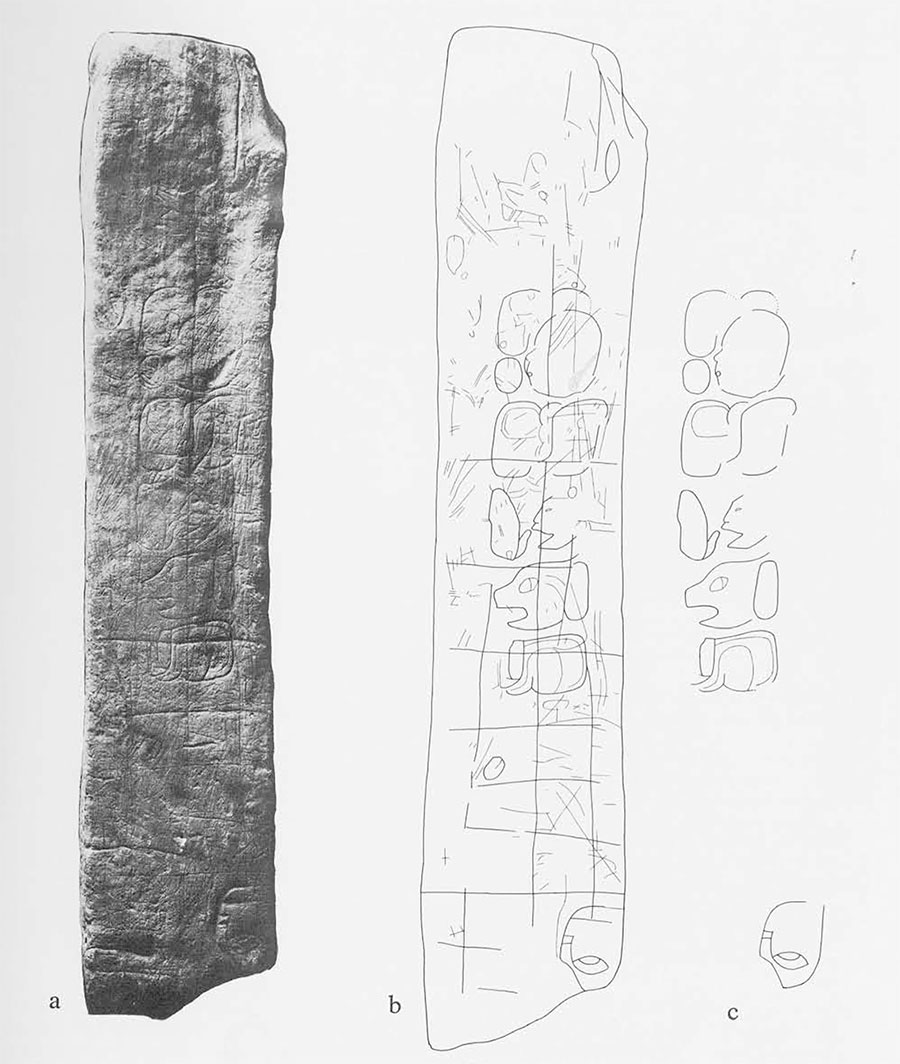
Our hypothesis includes the idea that the students were training to become carvers of monuments, on which hieroglyphs and elaborately costumed human figures appear constantly. In carving the monuments very low relief was the rule, accented by cutting away at the peripheries of the forms being depicted. In addition, there was a great deal of simple incising for details. The designs on our stones are for the most part merely incised, but as practice drawings, this hardly takes them outside the tradition of monument carving, and some cutting away of background is present on two of the stones. As to subject matter, hieroglyphs on four of them are definitely within that tradition, as are profile human faces not associated with glyphs on one of them.
The most satisfactory example is Miscellaneous Sculptured Stone 8, the shape of which has no known significance. The stone has two opposite flat triangular surfaces and two more-or-less rectangular ones accounting for the thickness of the slab. These latter were probably artificially smoothed–in this case, something not required for a building stone. The short edge-surface closing the triangle is a fractured one and uncarved. Starting with the more interesting of the edge surfaces the four flat and carved faces are numbered in sequence. For easy reference these surface numbers may be added to the stone number in parentheses. MSS-8(4) is flat but seems to have lost its smoothness by weathering. A number of straight incised lines still appear on it here and there. We illustrate only Surfaces 1, 2, and 3, in Figs. 2-5, and discuss them in that order.
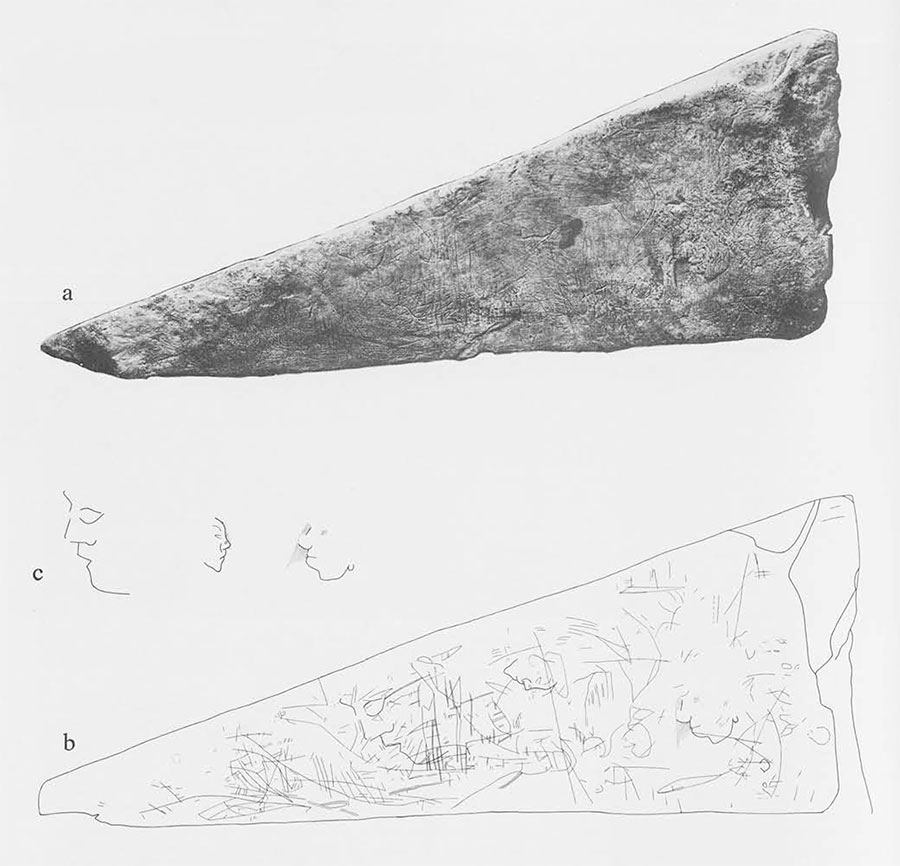
MSS-8(4) is covered by Fig. 2 a-c. The drawings emphasize the fact that it bears a column of five hieroglyphs. Considering the narrowness of the field, the artist may have pretended to himself that he was placing a text on the side of a miniature stela, the position being a common one on real stelae at Piedras Negras. Conceivably this is why he smoothed down the presumably original fracture surfaces of the long edges of the stone. No glyph-form is repeated, as might happen when painted glyphs on pottery were merely decorative–another pseudo-realistic detail. However, the glyph outlines have a cursive quality recalling painted ones. This is not characteristic of Piedras Negras inscriptions on stone though it appears on two of the Museum’s stelae from Caracol.
With the exception of Glyph 5, the lowest in the column, these signs seem to lack interior details. They are clearly unfinished, but there is no reason for thinking they are not partial copies of complete models. Maya glyphs may consist of a single “main sign” filling the allotted space (“glyph block”), or there may be a main sign with on or more smaller “affix” signs. These are distinguished by position as prefixes and post-fixes, to left and right of the main sign, respectively; or as superfixes and subfixes, above and below the main sign. In this unfinished panel, Glyphs 1, 2, and 3 had prefixes, and Glyph 1 seems to have also had a superfix.
Main signs come in two sorts–human, animal, or grotesque heads in left profile (“personalized” or “head-variant” glyphs); and “normal” or “symbolic” glyphs which have no recognizable pictorial character. The main sign of Glyph 1 seems to be a human head, those of Glyphs 3 and 4 are animal heads. Probably that of Glyph 3 is a combination of human nose and frog mouth. The head forming Glyph 4 seems to be that of a mammal, perhaps a dog. The affixes and the final Glyph 5 are symbolic forms. Conceivably an actual functioning column of glyphs may have been the model, but normally one finds at least two columns side by side.
In the lower right corner is a strange but recognizable face, possibly human. As shown, it is upside down. Evidently for carving this face the orientation of the stone differed from that for the glyphs by 180 degrees. A beginning has been made at cutting away the background before the face. Cutting across it slightly, and over most of the glyph column, are straight parallel lines forming two columns of rectangular spaces, as if these were being marked out for a two-column inscription. I will call the pattern a “grid” and cite another one in Fig. 6 as good evidence that, in our present context at least, such incised patterns had that function, and were “glyph grids.” However, this one was not used as such, perhaps because it was so poorly drawn. On the other hand, lack of an accurately drawn one-column grid as control in carving the column of five glyphs may account for their failure to be more or less standardized as to the widths and heights of the occupied spaces.
Presumable the glyphs, the stylized face, and the grid, were incised at different times, even if by one person. The same may be said for a fourth feature of this surface. This consists of systems of more or less parallel lines, a few of which are shown in our drawing, Fig. 2b. They appear in the areas of the grid and the glyphs, as well as outside. I will use “doodles” as a catch-all nickname for these and other lines not readily describable, though, being incised they were not made so easily as we might do with pencil and paper. Considering the general context, they probably represent practice in the basic art of making an incised line take the desired course. While straight lines predominate on this surface, curved ones may enclose ovoid areas. For example, the “pointed oval” at upper right might be a trial for the outline of the eye in the upside-down face at lower right. There is nothing on this surface, I think, which might not have been produced by an embryo glyph-carver learning his trade.

Turning to the triangular surface, MSS-8(2) shown in Figs. 3 and 4, there is more variety in the “doodling” and more of it. It is unrelated to three profile human faces which it cuts across. The “doodles” and two of the faces appear to best advantage in the detail photographs of Fig. 4. These faces are realistic ones, but not complete heads, recalling the profile faces of the priestly portraits of the monuments, in which the top and back of the head is hidden by the headdress. Here, in two cases there is a considerable or slight cutting away of background.
The three heads are unrelated to each other, being at different scales and at different attitudes with reference to the triangular field. The profiles depicted are also different, as would be the case with practice at portraiture. The two largest faces are left profiles, the usual view on the monuments which rarely show the right side, as in the smallest face here.

Among the “doodles” are long straight or curved lines unrelated to various apparently organized groups of lines. Especially interesting are parallel double lines cutting across the chin of the largest face. They show clearly at the extreme right of Fig. 4a. The two lines forming a single double line are perfectly parallel, though only a millimeter or so apart. One wonders if these were made with a damaged tool which had two points by chance. I doubt if such a close double-lining occurs on the monuments.
Surface 3 of this stone is shown only by the photograph of Fig. 5. “Doodling” is present over much of this surface. Near the center, parallel straight lines cross what seem to be the chin and lips only of a right profile face. Possibly, further study would justify seeing two other faces. Lower down is a faintly incised grid, at small scale. Again we seem to have practice drawing of a glyph-grid, without intention to actually use it. There are two or four columns of rectangles, depending on how one turns the stone.
I have already referred to the grid of Fig. 6, which shows Miscellaneous Sculptured Stone 3. Here we have a grid with empty squares, but also others which are used to control partial glyph carving within them. The description as “glyph-grid” is surely justified here. If we turn the stone as shown in the figure, or if we rotate it 180 degrees, we have a pair of columns, the usual thing on the monuments, but also an extra column, of three rather than four blocks. The stone may be a capstone from a vault which broke and was trimmed down for use a second time in the platform masonry where it was found. If so, additional rows of columns may have been lost. The correct orientation is unknown. But no matter how we orient the known squares, or those of a hypothetically reconstructed larger grid, in normal order of reading blank spaces appear between those which have been partially carved.
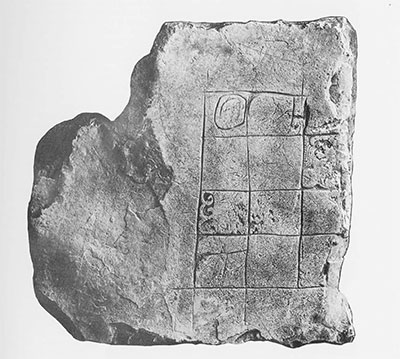
Obviously no connected series of glyphs was used as a model. First we have a poorly executed grid, and then random selection of certain blocks for further working. In two of these, incised lines seem to mark off spaces for main sign and affixes. In another, an incomplete double-line oval or cartouche is so placed as to allow for affixes on adjacent sides. In another rectangle, three side-by-side scrolls are partly defined by background removal. This could be a faulty attempt to carve a known affix consisting of three side-by-side “hooks,” but the main sign to which they should be attached is not indicated.
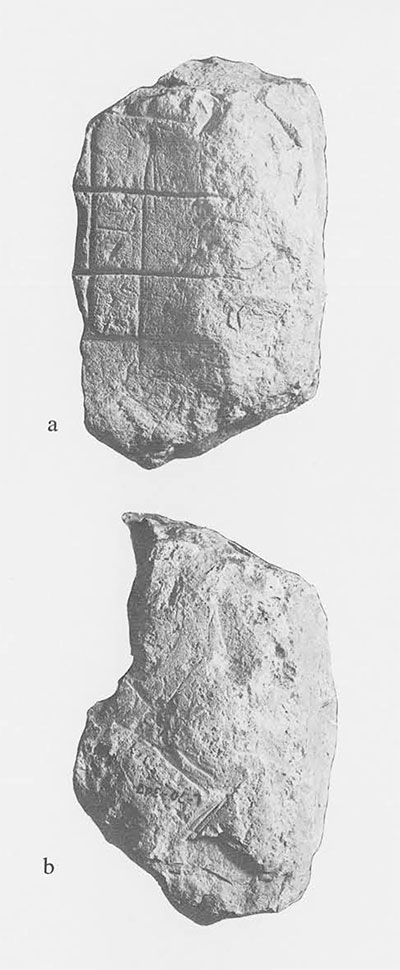
The fifth worked block gives the impression of an exercise in fitting several affixes into the allotted square, again without first outlining the main sign. Background cutting outlines a form like an elephant trunk, which occurs as part of a known affix. Proceeding from the end of the “trunk” is a well-known and well-executed “sun beard” or “wing” affix, ending near an unfinished oval form on the same side. Background cutting is evident here also. Surely practice work is the best explanation for the random distribution of the worked blocks, and the various degrees of completeness in depicting individual elements.
The grid itself is carelessly drawn, and several lines extend beyond the area of the rectangles, as is the case with the not-used grids on the triangular stone first described. This is true also when we turn to Surface 1 of Miscellaneous Sculptures Stone 20 shows in Fig. 7a. But there is a new variation. In terms of the orientation of the figure the four horizontal lines of the grid extend to the limit of the smooth surface, that is to an irregular margin on one side, and a break-off line on the other. The first vertical line is farther to the right of the left margin than is necessary and there appear to be false starts at the level of the lowest rectangle. It is clear that originally there may have been at least two columns of three glyph-block spaces each, most of a second column being on a broken-off and missing fragment. The artist achieved rather good rectilinearity for the upper two blocks, though they are of unequal height. As with the other grids, failure to stop all lines where they have defined the rectangles suggests that he was not planning to carve a functional text.
In all three of the preserved rectangles, beginnings at glyph carving seem to have been made, but not to the point where something recognizable can be described. The relatively tall central block seems to have been divided by an incised straight line into upper and lower halves, as occurs sometimes in actual texts.
The other side of this fragment is shown in Figs. 7b. Straight lines form a zigzag pattern–perhaps a “doodle” related to the grid pattern. The use of both sides is fair notice that this stone is not a fragment of a once functioning monument, a fact borne out by the nature of the designs.
With Miscellaneous Sculptured Stone 21, shown in Fig. 8, we encounter still other variations. The carved surface is less smooth than are those of the other stones, there is no grid, and there are nevertheless two hieroglyphs. At first glance these seem to have been completely carved. Allowing for a missing upper fragment, two signs forming the right glyph were well fitted into a rectangular space, a bit wider than high. This, however, is not true of the left glyph. Here, forming a highly irregular total outline, is a main sign with a two-element superfix, a subfix, and a large prefix. I think the whole pattern, thus described, justifies our orientation with the pointed end of the stone downward. It then follows that the first and larger sign of the second glyph is a hand with four fingers extended downward, and apparently this sign was repeated on the right, with less regular depiction of the fingers. The effect is one of extreme crudeness not found on Piedras Negras monuments, but better-executed functional glyphs may have been the models.
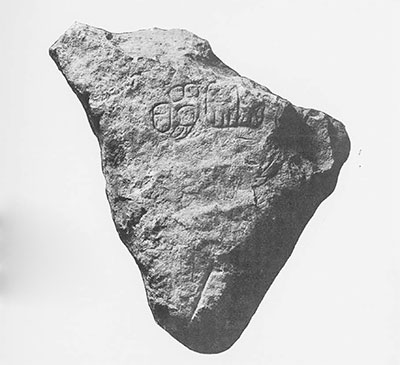
The surface does not seem to be weathered, and if not, absence of expected interior incised details in both glyphs suggests an unfinished product. While in the prefix a bold incised line has partly marked off upper and lower portions, it peters out before reaching the right side of the oval outline. Straight-line “doodles,” varying from faint to very deeply cut, appear below the supposed “double hand glyph” and also near the point of the stone.
It is natural to compare these glyphs with a functional two-glyph statement carved on the edge of Miscellaneous Sculptured Stone 19, in place and visible in an exterior wall of Structure J-9. Our fragment comes from collapsed outer wall masonry of the same building, or from the hearting behind it. If any part of it was visible in the wall this was surely a now lost edge, not the carved wider surface bearing the glyphs. A further distinction is that the functioning pair of glyphs was on a specially smoothed portion of the surface, not a rough one as here. The features noted seem to justify classifying the stone of Fig. 8 as a fourth practice piece.
The fifth stone of the series, Miscellaneous Sculptured Stone 6, carries the charming incised profile drawing of an animal, surely a deer, shown in Fig. 9. It is entirely outside the formal tradition of the art of the monuments. Instead, it reminds one of the freely drawn graffiti on plaster walls at Tikal. Helen Webster recently reproduced many of those in Expedition, Vol. 6, No. 1.
This Piedras Negras drawing is on fairly hard stone, not the more easily incised plaster. From the point of view of realism, if that was intended, it is incomplete. It lacks feet, there seems to be no eye, and the lines defining the mouth are much more faintly incised than lines elsewhere. Unrealistically, the legs start at the backbone. The complete stone was only roughly rectangular and the deer, the only design, was near one side, and its horizontal did not correspond with either axis of the stone. Clearly, this drawing was made on a building stone and was not intended to remain visible as a work of art.
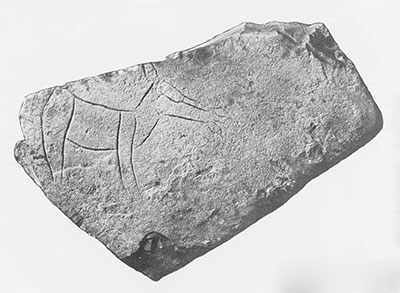
Nevertheless a creditable life-like effect was achieved with a few well-placed lines, and if this is another practice exercise by an apprentice sculptor, he was well advanced in his training. One may imagine that such a one, of the Master himself, dashed it off for the fun of it, for the moment putting aside the restrictive conventions which normally had to be followed.
The practice-carving function for the designs on the other four stones seems rather well established, along with a direct relationship, through hieroglyph depiction especially, to the designs of the monuments. Perhaps this function for the “doodles” is more dubious, but even so there arises a presumption that these designs date from the local period of monument carving, which seems to have covered a time-span of about two and a half centuries, probably from about A.D. 550 to A.D. 801. A rather good case can be made for dating the three buildings and one platform unit, in which it is known that all five stones were used, as having been built within, say, the last half of that period. The carvings may have been correspondingly late within the period, but not necessarily so in any particular case. It is probable that building stones were used again and again as new structures replaced old ones at the same or neighboring locations. This may have happened with re-used fragments of broken-up carved monuments, and also with these building stones carved for more transitory purposes before the first of two or more uses in architectural construction.
I would not suggest that these finds are of very great importance to the history of Maya sculpture, but I do think they amount to an interesting footnote well worth recording. If similar ones had been reported elsewhere I have missed them. Not being expected, many examples may have been missed in excavations of collapsed masonry, and others may be invisible in still-standing masonry. Therefore the rarity of these types of evanescent sculpture, as known, may be a matter of chance. Looking for them in future excavations in the Usumacinta area of “slab” masonry seems indicated.
